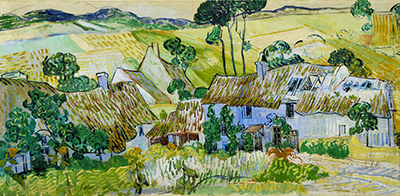Painted in the month that he died, Van Gogh's oil painting Farms near Auvers appears to be unfinished when considered with an authoritative eye, with some of the most distant mountains barely outlined and a lack of the detail that usually suffuses a Van Gogh.
The painting has an alternative name Thatched Cottages by a Hill, and it is based on scenes that Van Gogh would have seen in the last few weeks and days of his life. He wrote to his sister, Wilhelmina (affectionately known to him as Wil) about the 'superb' 'roofs of mossy thatch' which he knew he would be compelled to paint. Auvers-sur-Oise is a small commune (a French word loosely translating to a 'civil township') just outside Paris, which became affiliated with many of the French avant garde artists of the 1800s who lived, worked and recuperated in the beautiful location.
The artists all painted in very different styles: Daubigny followed the Barbizon school of beautiful realism, Cezanne's style was post-impressionist and Pissarro was still enamoured of impressionism. Van Gogh was, of course, unique and experimental, moving between the labels of post-impressionist, neo-impressionist and pointillist without ever quite satisfying the rules for any of them.
His style is often the subject of conjecture and debate amongst both artists and medical professionals, with theories abounding as to why he painted in the style he did. Lead poisoning can cause a person to see halos of light around bright objects, and lead was commonly found in household products in those days, being used for metal steins, toys, and even put into paints. This, say some theorists, could explain why Van Gogh often included nimbuses of light around objects that would not usually have them. Another theory is that Van Gogh was receiving digitalin from his doctor, to treat what is believed to have been temporal lobe epilepsy.
Digitalin can affect the way eyes see colours, casting a yellow sheen over the world. This would go some way to explaining the prevalence of yellow in Van Gogh's older works, such as this one. It is true that the painting does have a lot of yellow under close examination: the horizon is picked out in pale yellow, the fields, house walls, gardens and the thatched roofs all have undertones of yellow. And yet, there is an impression of accuracy rather than that of a yellow filter being applied over the scene and it would be a brave critic to state that any of the yellow shading or highlighting is unnecessary.
After all this time, and with the painting apparently unfinished, it is impossible to use this work to confirm or deny the theory. At this time, towards the end of his life, Van Gogh was using, almost exclusively, canvases known as 'double squares', rectangular canvases of 50 centimetres high by one metre wide, and this painting is no exception, measuring slightly over those dimensions, by a centimetre or two. It can currently be seen hanging in the Tate Gallery in London, to which it was bequeathed in 1933 by C Frank Stoop, a Dutch born art collector.




